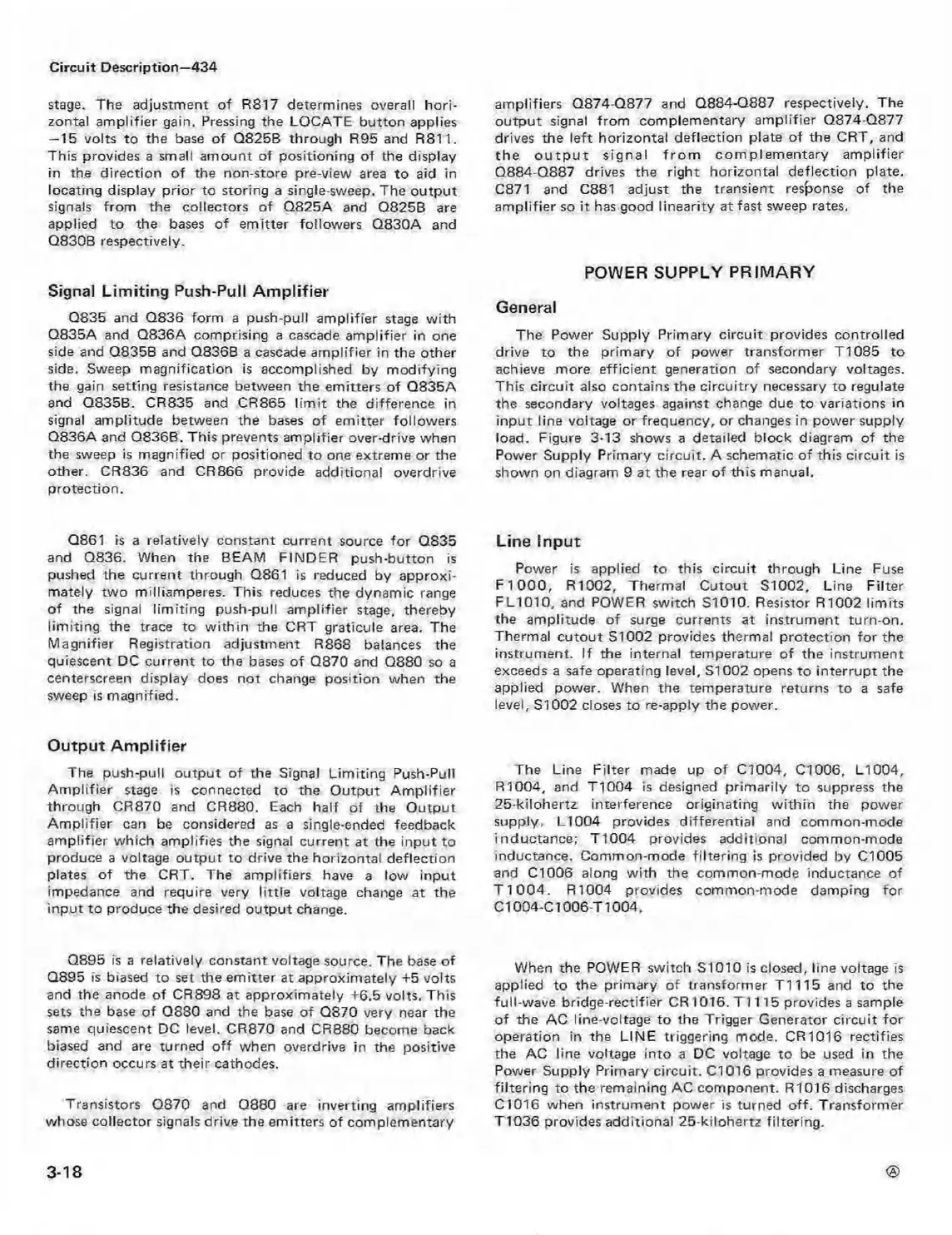Circuit Description—434
stage. The adjustment of R817 determines overall hori
zontal am plifier gain. Pressing the LOCATE button applies
— 15 volts to the base of Q825B through R95 and R811.
This provides a small amount of positioning of the display
in the direction of the non-store pre-view area to aid in
locating display prior to storing a single-sweep. The output
signals from the collectors of Q825A and Q825B are
applied to the bases of em itter followers Q830A and
Q830B respectively.
Signal Limiting Push-Pull Am plifier
Q835 and Q836 form a push-pull amplifier stage w ith
Q835A and Q836A comprising a cascade am plifier in one
side and Q835B and Q836B a cascade amplifier in the other
side. Sweep magnification is accomplished by modifying
the gain setting resistance between the emitters of Q835A
and Q835B. CR835 and CR865 lim it the difference in
signal amplitude between the bases o f emitter followers
Q836A and Q836B. This prevents amplifier over-drive when
the sweep is magnified or positioned to one extreme or the
other. CR836 and CR866 provide additional overdrive
protection.
Q861 is a relatively constant current source for Q835
and Q836. When the BEAM FINDER push-button is
pushed the current through Q861 is reduced by approxi
mately two milliamperes. This reduces the dynamic range
of the signal lim iting push-pull am plifier stage, thereby
limiting the trace to w ithin the CRT graticule area. The
Magnifier Registration adjustment R868 balances the
quiescent DC current to the bases of Q870 and Q880 so a
centerscreen display does not change position when the
sweep is magnified.
Output Am plifier
The push-pull output of the Signal Lim iting Push-Pull
Am plifier stage is connected to the Output Am plifier
through CR870 and CR880. Each half of the O utput
Am plifier can be considered as a single-ended feedback
amplifier which amplifies the signal current at the input to
produce a voltage output to drive the horizontal deflection
plates of the CRT. The amplifiers have a low input
impedance and require very little voltage change at the
input to produce the desired output change.
Q895 is a relatively constant voltage source. The base of
Q895 is biased to set the em itter at approximately +5 volts
and the anode of CR898 at approximately +6.5 volts. This
sets the base of Q880 and the base of Q870 very near the
same quiescent DC level. CR870 and CR880 become back
biased and are turned o ff when overdrive in the positive
direction occurs at their cathodes.
Transistors Q870 and Q880 are inverting amplifiers
whose collector signals drive the emitters of complementary
amplifiers Q874-Q877 and Q884-Q887 respectively. The
output signal from complementary amplifier Q874-Q877
drives the left horizontal deflection plate of the CRT, and
th e o u tp u t signal fro m com plem entary am plifier
Q884-Q887 drives the right horizontal deflection plate.
C871 and C881 adjust the transient response of the
am plifier so it has good linearity at fast sweep rates.
POWER SUPPLY PRIMARY
General
The Power Supply Primary circuit provides controlled
drive to the primary of power transformer T1085 to
achieve more efficient generation of secondary voltages.
This circuit also contains the circuitry necessary to regulate
the secondary voltages against change due to variations in
input line voltage or frequency, or changes in power supply
load. Figure 3-13 shows a detailed block diagram of the
Power Supply Primary circuit. A schematic of this circuit is
shown on diagram 9 at the rear of this manual.
Line Input
Power is applied to this circuit through Line Fuse
F I 0 0 0 , R1002, Thermal Cutout S1002, Line Filter
FL1010, and POWER switch S1Q10. Resistor R1002 limits
the amplitude of surge currents at instrument turn-on.
Thermal cutout S1002 provides thermal protection for the
instrument. If the internal temperature of the instrument
exceeds a safe operating level, S1002 opens to interrupt the
applied power. When the temperature returns to a safe
level, S I002 closes to re-apply the power.
The Line F ilter made up of C1004, C l006, L I004,
R1004, and T1004 is designed prim arily to suppress the
25-kilohertz interference originating w ithin the power
supply. L I004 provides differential and common-mode
inductance; T1004 provides additional common-mode
inductance. Common-mode filtering is provided by C l005
and C l006 along w ith the common-mode inductance of
T 1 0 0 4 . R1004 provides common-mode damping for
C1004-C1006-T1004.
When the POWER switch S1010 is closed, line voltage is
applied to the primary of transformer T1115 and to the
full-wave bridge-rectifier C R 1016. T 1 115 provides a sample
of the AC line-voltage to the Trigger Generator circuit for
operation in the LINE triggering mode. CR1016 rectifies
the AC line voltage into a DC voltage to be used in the
Power Supply Primary circuit. Cl 016 provides a measure of
filtering to the remaining AC component. R1016 discharges
C1016 when instrument power is turned off. Transformer
T1036 provides additional 25-kilohertz filtering.
3-18

